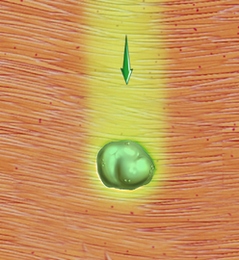Intensively-modulated radiation therapy – IMLT
Description intensely-modulated radiation therapy
Radiation therapy It uses radiation, to kill cancer cells and shrink tumors. Some healthy cells are also damaged by radiation. A view to radiation therapy is to kill as many cancer cells, limiting damage to healthy cells.
Intensively-modulated radiation therapy (IMLT, also used the name of radiotherapy with modulated intensity (LTMI)) It is one of the methods of treatment of cancer. The procedure uses radiation beams of different intensities. Appropriate doses of radiation directed at the tumor and reduce the exposure of the surrounding healthy tissue.

Reasons for intensive-modulated radiation therapy
Radiation therapy is used, to destroy or shrink the tumor, and to eliminate or prevent the spread of cancer. It can also be used to alleviate symptoms, caused by a tumor (eg, pain, bleeding). Compared with conventional radiotherapy, using IMRT to the tumor can be safely deliver high doses of radiation. High dose may increase treatment success.
Possible complications of intensive modulated radiotherapy
LTMI, usually, It causes fewer side effects compared with conventional radiotherapy. Side effects vary from patient to patient, depending on the location of cancer. Some patients experience no side effects. Common side effects of radiation therapy may include:
- Fatigue;
- Skin changes;
- Hair loss;
- Loss of appetite;
- Specific side effects, associated with the area of the body, to which a treatment.
Despite the inconvenience, side effects, associated with radiotherapy, usually, not serious. They can be reduced by taking medications and ensuring proper nutrition. The oncologist can explain the cause of the side effects, and help determine the best methods to avoid them.
How is intensely-modulated radiation therapy?
Preparation for the procedure
Planning for IMRT is complex and usually takes 2-5 days. Scheduling may include:
- Inspection;
- Conducting one or more tests to take pictures of the area of the body, which will be directed radiation beams. The tests used may include:
- Roentgen – test, which uses radiation, to take pictures of structures inside the body;
- CT scan – such as X-rays, which uses computer, to make pictures of structures inside the body;
- MRT – test, which uses magnetic waves, to make pictures of structures inside the body;
- PET – test, which uses a special camera for viewing structures within the body after administration of the radioactive solution into the vein;
- CT / PET – simultaneous both studies, which provides improved accuracy test;
- Marking places on the skin, which will be directed radiation;
- Installing the devices (eg, mask, supporting frame), which may increase the accuracy of irradiation;
- Using ultrasound or implanted markers to track the position of the tumor.
Procedure intensive modulated radiotherapy
Using a marker on the skin as a guide, radiologist places the patient on the treatment table. To verify the accuracy of positioning may be used or ultrasound images. The therapist leaves the room, to control the movement apparatus for the irradiation. The procedure provides radiation in three dimensions. This helps focus it on the tumor. A healthy tissue receives smaller doses of radiation, than the tumor.
After the procedure, radiation therapy to stay for a while in the office for radiation. Generally, you will not feel or sense anything during treatment. Nonetheless, the apparatus may be stopped, If you feel pain or discomfort. Your doctor will monitor your condition with the help of the camera. You will be able to talk to him on the intercom, if required.
Immediately after intensive modulated radiotherapy
You will be able to resume normal daily activities. Intensively-modulated radiation therapy does not make you radioactive, and you do not need, avoid other people after treatment.
How long will it take intensive modulated radiotherapy?
Each session lasts 15-30 minutes. Patients, usually, We need to undergo IMRT five days per week for 4-8 weeks.
Intensively-modulated radiation therapy – Will it hurt?
Anchoring in a fixed position can be a little uncomfortable, but it does not hurt.
Treatments after intensive modulated radiotherapy
During treatment, you need to visit a doctor at least once a week. During the course of treatment may be prescribed blood tests and other tests.
After completion of treatment you need to see your doctor regularly, to monitor side effects, effectiveness of treatment and to check for signs of recurrent disease. You may need further testing, medications or medical rehabilitation. Be sure to follow your doctor's instructions.
Contact your doctor after intensive modulated radiotherapy
After treatment and return home need to see a doctor if you experience these problems:
- Persistent pain;
- New or unusual swelling or swelling;
- Nausea, diarrhea, vomiting, loss of appetite;
- Unexplained weight loss;
- Cough, sore throat or fever, which does not pass;
- Unusual changes in the skin, including rash, bleeding or bruising.
- Other troubling symptoms.
